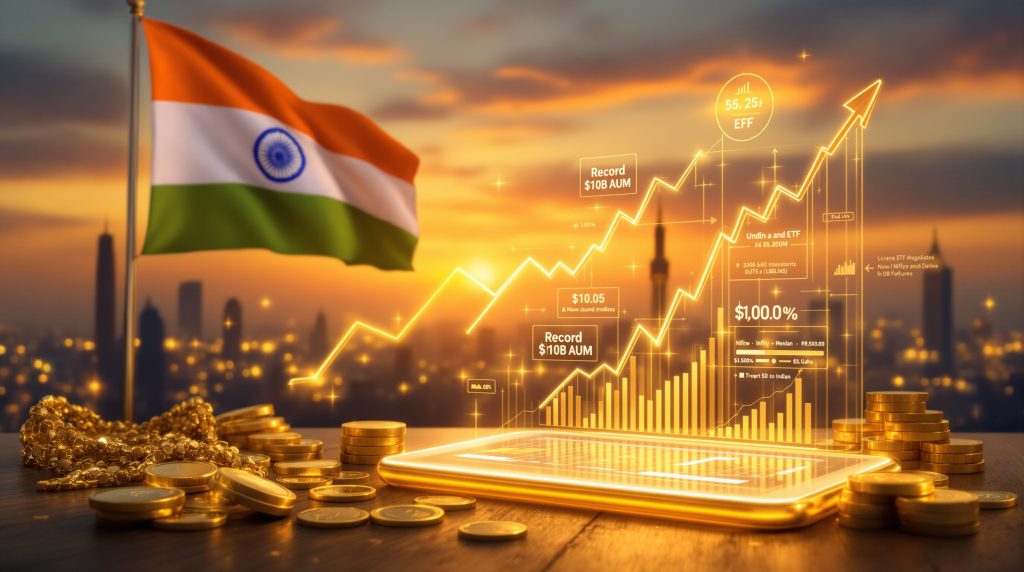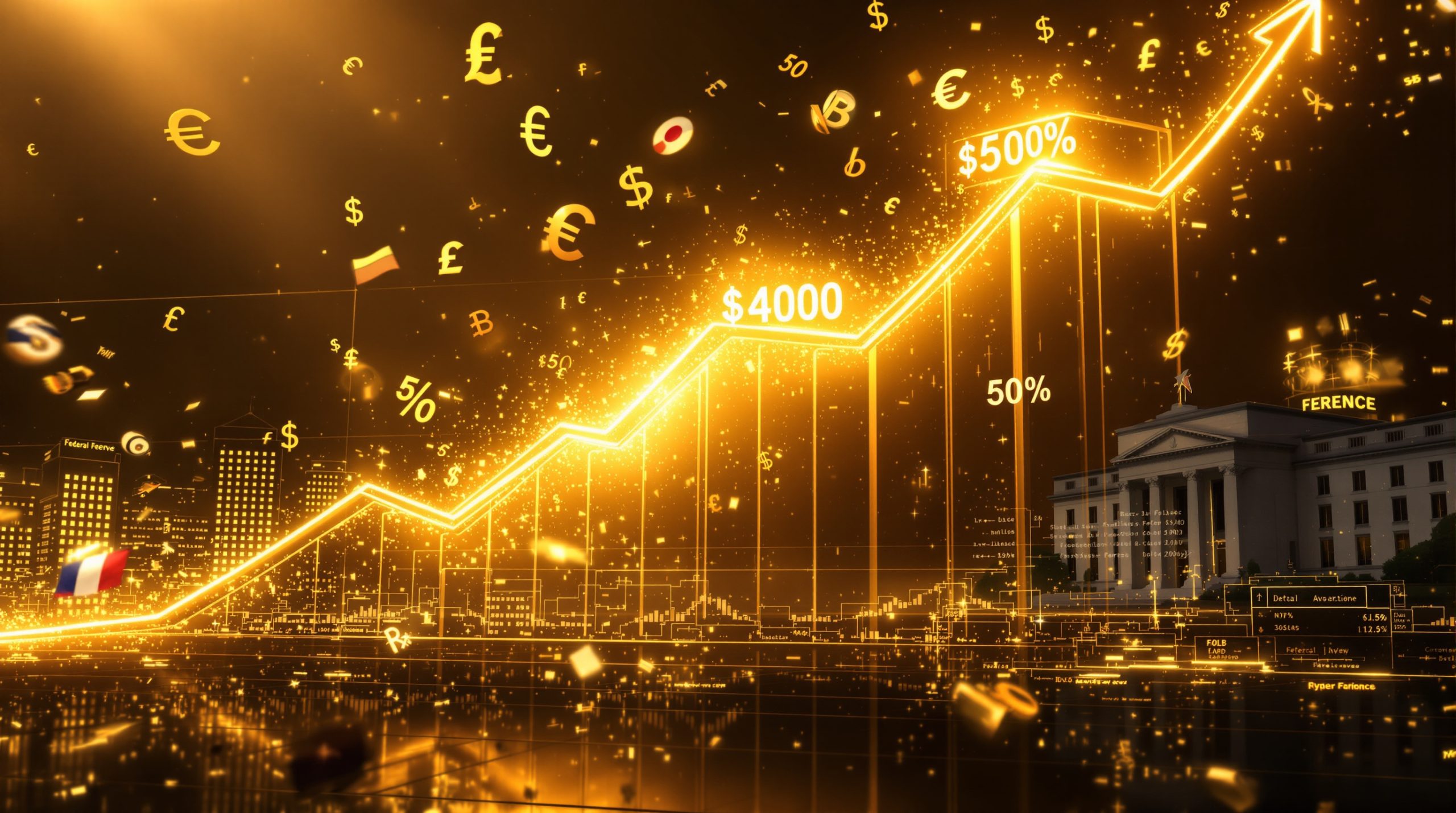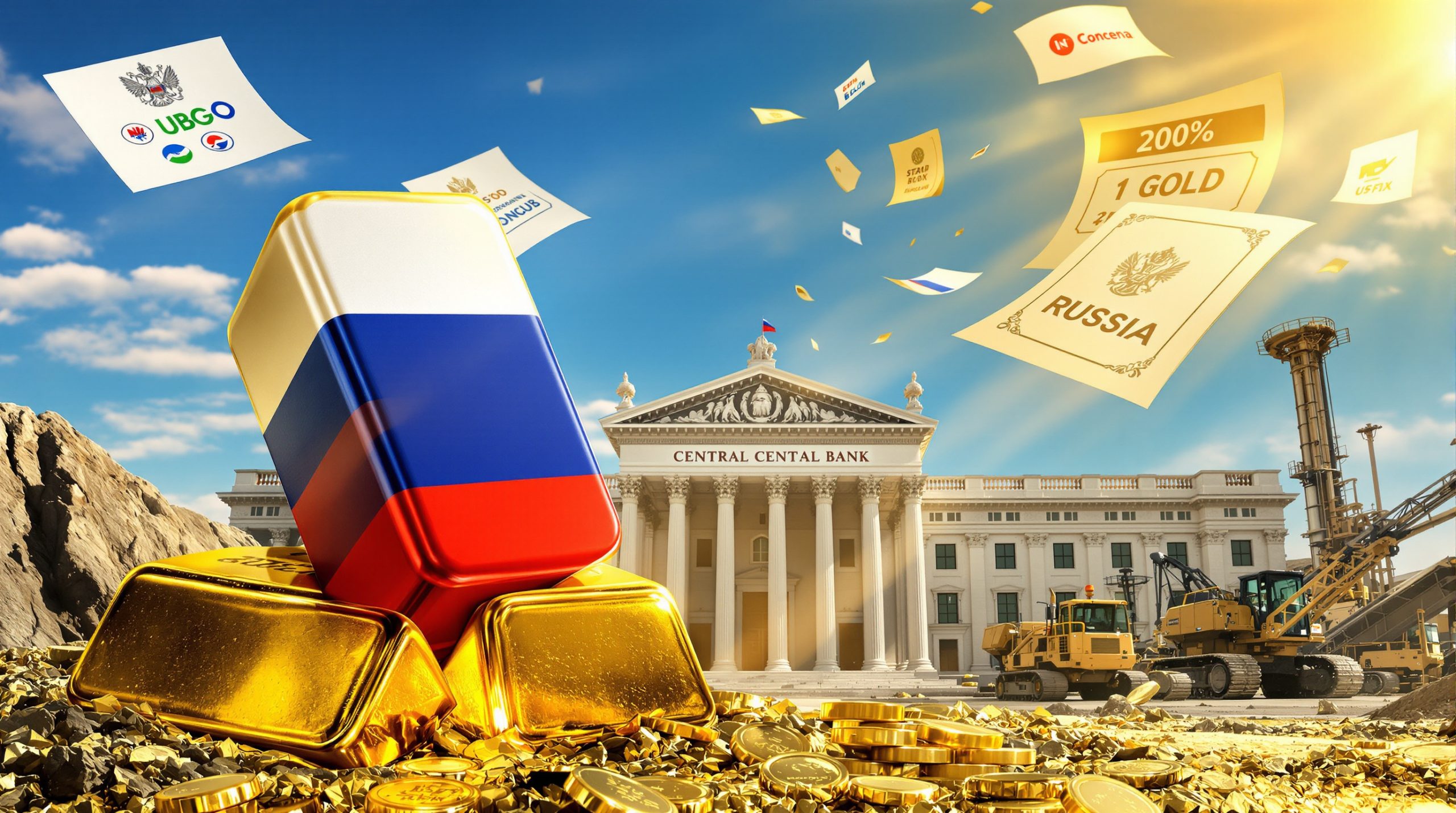Why Are India's Gold ETFs Experiencing Unprecedented Growth?
The traditional image of gold investment in India is rapidly evolving. Urban investors are increasingly turning to gold exchange-traded funds (ETFs) as their preferred investment vehicle, driving assets under management (AUM) to an all-time high of $10 billion in September 2025. This shift represents a fundamental transformation in how Indians approach gold investment in the digital age.
The September 2025 Surge: Breaking All Records
September 2025 marked a watershed moment for India's gold ETF market, with unprecedented activity across all metrics. Investors poured $902 million into gold ETFs during this single month, representing the largest monthly inflow ever recorded. This influx added 7.3 tons of gold to ETF holdings, pushing total holdings to a record 77.3 tons.
Year-to-date inflows reached $2.18 billion by the end of September, already surpassing all previous annual totals. This dramatic growth contrasts sharply with historical figures: inflows were $1.28 billion in 2024, just $295.3 million in 2023, and a mere $26.8 million in 2022—revealing an exponential growth trajectory that shows no signs of slowing.
What's Driving Indian Investors Toward Gold ETFs?
Underperforming Equity Markets vs. Soaring Gold Prices
The performance gap between traditional investments and gold has become impossible for investors to ignore. While the Nifty 50 Index managed only a modest 6% gain year-to-date in 2025 (following 8.8% in 2024), gold prices in India have skyrocketed by 60% during the same period, after already gaining 21% in 2024.
| Investment Type | 2025 Performance (YTD) | 2024 Performance |
|---|---|---|
| Gold (local price) | +60% | +21% |
| Nifty 50 Index | +6% | +8.8% |
With gold prices reaching a record 122,829 rupees per 10 grams in October 2025, the precious metal has outperformed equities by a factor of 10 in 2025 alone. This striking performance differential has forced many investors to reconsider their asset allocation strategies in light of the latest gold prices analysis.
Economic and Currency Factors Fueling the Gold Rush
Several macroeconomic factors are converging to make gold ETFs particularly attractive in the current environment:
-
Rupee Weakness: The declining value of the Indian rupee has enhanced gold's appeal as a currency hedge, particularly among sophisticated investors
-
Global Uncertainties: Ongoing geopolitical tensions and trade disruptions have heightened demand for safe-haven assets
-
Inflation Concerns: Gold's traditional role as an inflation hedge has become more relevant amid economic uncertainty
-
Accessibility: ETFs offer easier entry points compared to physical gold, with lower transaction costs and no storage concerns
The World Gold Council has noted that this combination of factors—currency weakness, equity underperformance, and global uncertainties—has created ideal conditions for gold market surge in India.
How Are Investment Patterns Changing in India's Gold Market?
From Physical Gold to Digital Investment: A Cultural Shift
India's relationship with gold is undergoing a profound transformation. Historically, Indians have favored physical gold in the form of jewelry, coins, and bars—not just as adornment but as a store of wealth passed through generations. Today, however, urban investors are increasingly choosing gold ETFs for their convenience, transparency, and efficiency.
This shift is occurring across multiple investor segments:
- Retail Investors: First-time gold investors are bypassing traditional physical gold entirely
- Institutional Investors: Professional money managers are increasing gold allocations through ETFs
- HNIs: High-net-worth individuals are diversifying their gold holdings with ETF positions
- Young Investors: Millennials and Gen Z prefer digital gold investments that align with their technology-focused lifestyles
As Vikram Dhawan, head of commodities at Nippon India Mutual Fund (which manages India's largest gold ETF) observes, investors who previously had minimal gold exposure are now making it a core holding. This represents a fundamental shift in allocation strategy rather than merely a tactical move.
The Persistence of the Trend: Beyond Price Movements
Market analysts observe that the current ETF inflow trend appears sustainable for several reasons:
- Structural Change: The allocation shift appears structural rather than cyclical
- New Buying Behavior: Investors now view price corrections as buying opportunities rather than reasons to exit
- Convenience Factor: Even if gold prices stabilize, the convenience and efficiency of ETFs continue to attract new investors
- Professional Support: Financial advisors are increasingly recommending gold ETFs as part of diversified portfolios
The persistence of inflows despite occasional price fluctuations suggests that this trend has staying power beyond simple momentum chasing. Understanding the gold-stock relationship has become essential for modern investors.
What Are the Broader Economic Implications of This Trend?
Impact on India's Gold Imports and Trade Balance
The surge in ETF investments has significant implications for India's economy. As the world's second-largest gold consumer, India's growing appetite for the metal through ETFs directly translates to greater gold imports.
This increase in imports carries several economic consequences:
- Trade Deficit Concerns: Higher gold imports could widen India's trade deficit
- Currency Pressure: Additional gold imports may put further pressure on the already weakened rupee
- Global Price Support: Increased Indian demand provides support for global gold prices, which have recently hit record highs
- Monetary Policy Implications: The central bank may need to consider this shift in their economic forecasting
Each ton of gold added to ETF holdings represents roughly $65 million of imported gold at current prices, making the September 2025 inflow of 7.3 tons significant from a macroeconomic perspective.
India's Position in the Global Gold ETF Landscape
India's September inflow of $902 million positions the country as a major player in the global gold ETF market:
- Ranked 4th globally for monthly inflows in September 2025
- Led the Asia region, outpacing both China ($622 million) and Japan ($415 million)
- Contributed significantly to Asia's combined $2.1 billion in regional inflows
- Demonstrated the fastest growth rate among major gold ETF markets
While still smaller than North American and European markets in absolute terms, India's rapid growth rate suggests it could become an increasingly important factor in global gold demand. According to Reuters' analysis of record-breaking ETF flows, this trend is reshaping the global gold market landscape.
How Does India's Gold ETF Growth Compare Globally?
Regional and Global Context of India's Gold ETF Boom
While North America and Europe remain the largest gold ETF markets by total assets, India's growth rate stands out dramatically on the international stage:
| Region | September 2025 Inflows | Notable Trends |
|---|---|---|
| North America | $10.3 billion | Led by U.S. institutional investors |
| Europe | $3.7 billion | Diversification amid economic uncertainty |
| Asia | $2.1 billion | India leading with 43% of regional inflows |
| India | $902 million | Highest monthly inflow in country's history |
This positioning highlights India's emerging influence in the global gold investment landscape, particularly within Asia. The country's ETF growth rate far exceeds that of most developed markets, signaling a potential long-term shift in global gold investment patterns.
Comparative ETF Investment Dynamics
Different regions show distinct patterns in their ETF investment behavior:
- North America: Predominantly driven by institutional investors and inflation hedging
- Europe: Focused on currency diversification and geopolitical risk mitigation
- Asia: Led by retail investor participation and cultural gold affinity
- India: Unique combination of traditional gold culture transitioning to modern investment vehicles
These regional differences highlight the unique nature of India's gold ETF boom, combining traditional cultural affinity for gold with modern investment approaches. The gold price forecast suggests this growth may continue.
What Does the Future Hold for India's Gold ETF Market?
Growth Projections and Market Outlook
Based on current trends, market analysts project continued strong growth for India's gold ETF sector:
- ETF assets under management could potentially double within 18-24 months if current inflow rates persist
- The investor base is expected to broaden as more retail investors enter the market
- Financial institutions are developing new gold-linked investment products to capitalize on demand
- Digital gold platforms are likely to see integration with mainstream financial services
The strong momentum suggests that even if growth rates moderate somewhat, the overall direction remains firmly positive for the sector.
Potential Challenges and Limiting Factors
Despite the positive outlook, several factors could moderate growth:
- Equity Market Competition: A significant equity market rally could redirect investor attention
- Price Stabilization: Stabilization or decline in gold prices might temporarily slow inflows
- Regulatory Changes: Changes affecting gold imports could impact ETF operations
- New Competitors: Competition from newer investment vehicles like sovereign gold bonds
Disclaimer: Market projections are based on current trends and should not be considered as investment advice. Future performance may vary significantly from projections.
How Can Investors Navigate India's Gold ETF Landscape?
Key Considerations for Potential Gold ETF Investors
For those considering gold ETF investments in India, several factors merit careful attention:
- Expense Ratios: Annual management fees typically range from 0.5% to 1% across providers, significantly impacting long-term returns
- Tracking Error: Some ETFs follow gold prices more precisely than others due to management efficiency
- Liquidity: Trading volumes and bid-ask spreads affect execution prices, especially for larger transactions
- Tax Implications: Different holding periods have varying tax treatments under Indian tax laws
- Portfolio Allocation: Financial advisors typically recommend gold exposure of 5-15% of total investments
Investors should evaluate these factors carefully before selecting a specific gold ETF for their portfolios. The World Gold Council's data on global ETF holdings and flows provides valuable insights for informed decision-making.
Questions to Ask Before Investing in Gold ETFs
Potential investors should consider the following questions:
- What is the fund's expense ratio compared to competitors?
- How has the ETF performed relative to gold prices over various time periods?
- What is the average daily trading volume and liquidity?
- Does the ETF physically hold gold or use derivatives?
- What are the tax implications for your specific situation?
Answering these questions can help investors select the gold ETF that best matches their investment goals and constraints. Exploring various gold investment strategies can further enhance portfolio performance.
FAQs About India's Gold ETF Market
What is driving the record inflows into India's gold ETFs?
The unprecedented inflows are primarily driven by gold's strong price performance (60% gain year-to-date), weak equity market returns (6% for Nifty 50), currency depreciation, and increasing investor preference for convenient digital gold investments over traditional physical gold.
How do gold ETFs differ from physical gold investments?
Gold ETFs offer several advantages over physical gold: no storage concerns, no purity issues, lower transaction costs, easier liquidity, smaller investment amounts possible, and transparent pricing. However, they do involve annual expense ratios and require a demat account.
Will the trend of increasing gold ETF investments continue?
Market analysts believe the trend is sustainable due to structural shifts in investor behavior, ongoing economic uncertainties, and the growing acceptance of ETFs as a mainstream investment vehicle. Even if gold prices correct, many investors now view dips as buying opportunities.
How does India's gold ETF market compare to other countries?
While India's gold ETF market remains smaller than those in North America and Europe in absolute terms, it is growing at a faster rate and now leads the Asia region in monthly inflows. India's September 2025 inflow of $902 million ranked fourth globally.
The record inflow into India's gold ETFs represents more than just a market trend—it signals a fundamental shift in how one of the world's most gold-obsessed nations is rethinking its relationship with the precious metal in the digital age.
Ready to Capitalise on the Next Major Gold Price Movement?
Discover how the proprietary Discovery IQ model at Discovery Alert can instantly identify significant gold-related ASX announcements, turning complex data into actionable investment opportunities. Visit the Discovery Alert discoveries page to understand how major mineral discoveries, like those in the gold sector, have generated substantial returns for early investors.




